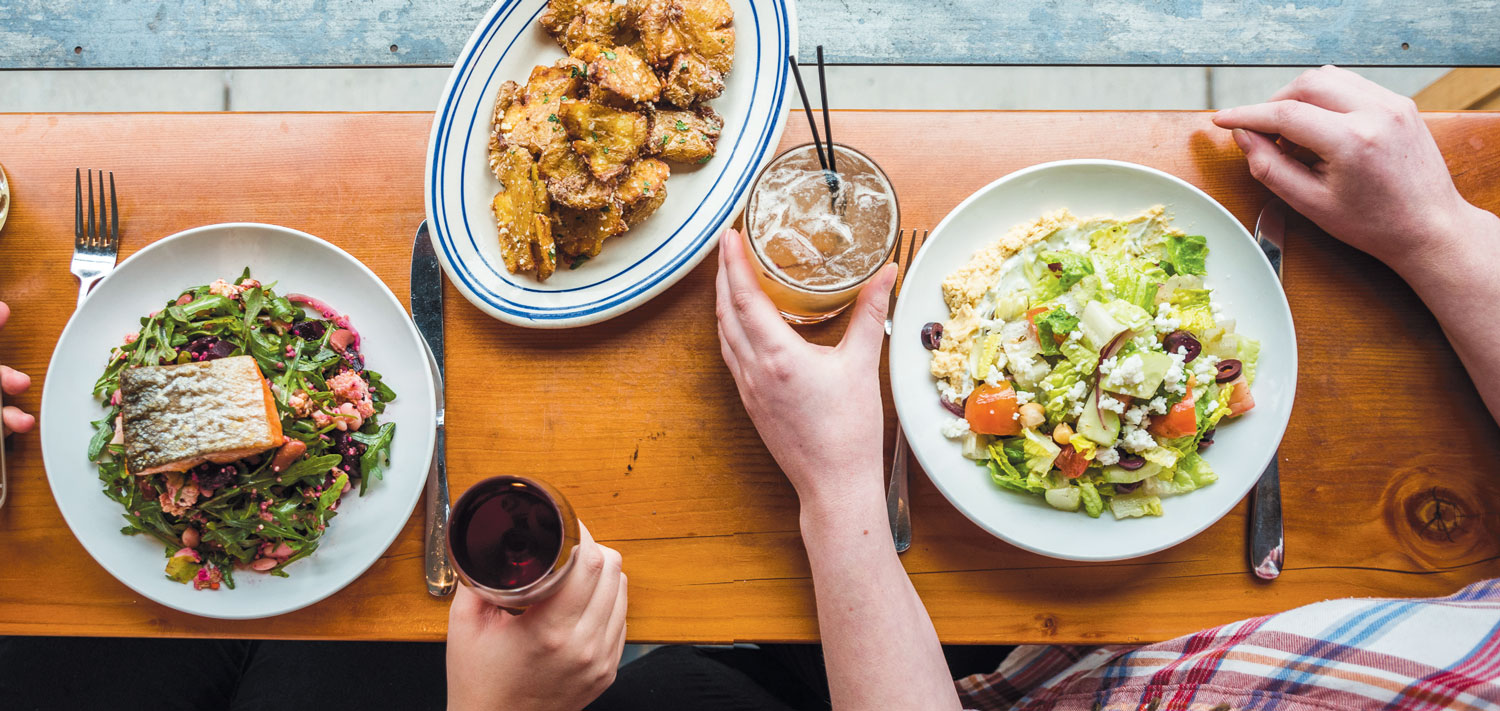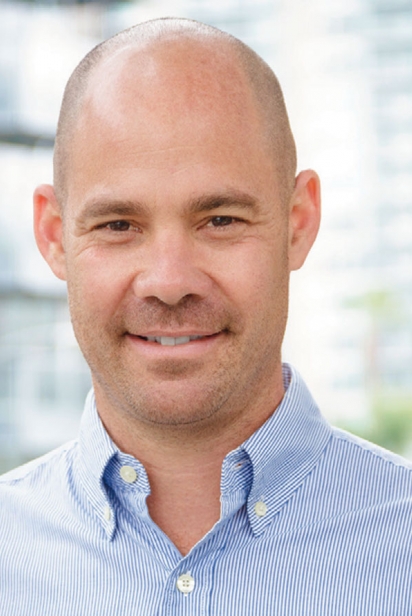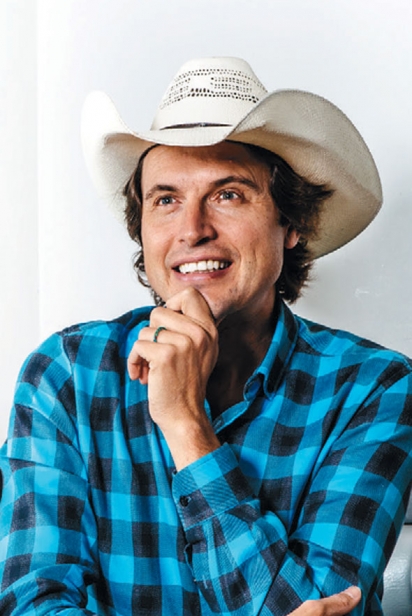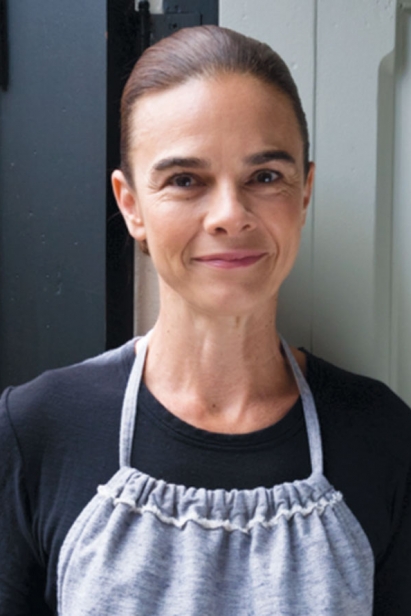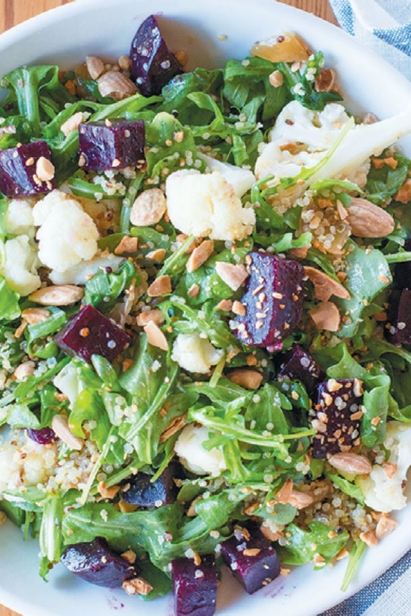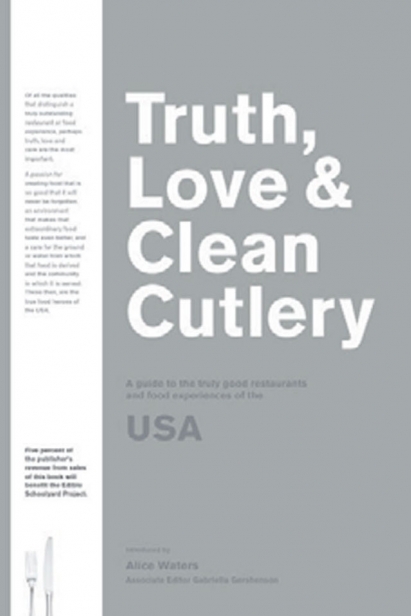Better Food for People + Planet
Chefs and restaurateurs explore the demand for transparency on the plate.
WHEN ERIK OBERHOLTZER, David Dressler, and Matt Lyman launched Tender Greens in 2006 in Culver City, California, they had a mission: to change the way people eat, not just in the Los Angeles area, but across the country. At the time the dining landscape was largely split between white-tablecloth restaurants and fast-food joints without much in the middle.
“If you wanted a good meal that aligned with your values, you had to pay for it,” Oberholtzer says. “We wanted you to pick what you wanted to eat instead of what you could afford.”
Their answer was Tender Greens, a fast-casual restaurant with scratch cooking and top-quality ingredients. The menu was designed to mimic the type of meals you would cook at home if you had the time: salt and pepper chicken, grilled salmon, spinach salad. These cravable dishes championed produce from nearby Scarborough Farms, grass-fed beef, and heritage pork. With the farm-to-table movement in full swing, Tender Greens could have simply been looked at as quaint. Except for the fact that Scarborough Farms was an equity partner, everything on the menu was $9, and the concept was built with national expansion in mind.
“One restaurant doesn’t make an impact,” Oberholtzer says. “Many do.”
Across the country in Atlanta, Georgia, Jason Mann and George Frangos opened Farm Burger in 2010 with a similar mission: to bring a high-quality, affordable burger made with impeccably sourced grass-fed beef to the masses.
“We didn’t want to be too didactic or preachy about it,” says co-owner and rancher Mann. “But we want people to ask ‘Why does this burger taste different? Why are there pictures of cows on the walls? Why are you putting me in the uncomfortable situation of seeing the animal I’m about to eat?’ We want to push that education.”
For many in the food industry, there are two critical figures in the farm-to-table movement: Alice Waters, who opened the legendary Chez Panisse restaurant in Berkeley, California, in 1979, and Carlo Petrini, who created the Slow Food Movement in Italy in 1986. To this day, Petrini’s approach is a democratic pushback against industrialization and homogenization. At the 2017 Slow Food Nations, an international gathering in Denver, Colorado, he said, “We don’t want food that doesn’t have an identity. High-quality food comes with a story.”
Chefs of all backgrounds have come to understand the value of those stories. Knowing thy farmer, rancher, and producer is not only critical for business, but also for flavor, nutrition, ingredient diversity, and the overall satisfaction that comes from enjoying a thoughtful meal. After all, who doesn’t want to eat a fairy-tale eggplant grown and harvested by an overalls-wearing farmer a few miles down the road? But it’s that very image that also underscores the real need for transparency.
“People buy their meat from the grocery, and there’s a picture of the sun over the horizon on a beautiful farm and they don’t even think of where it comes from,” says Kate Kavanaugh, co-owner of Denver’s Western Daughters Butcher Shoppe which opened in 2013. “Food is so many times removed from what it is.” That divorce from reality, coupled with inexpensive prices, has allowed Americans to conveniently overlook the negative impacts of commodity food.
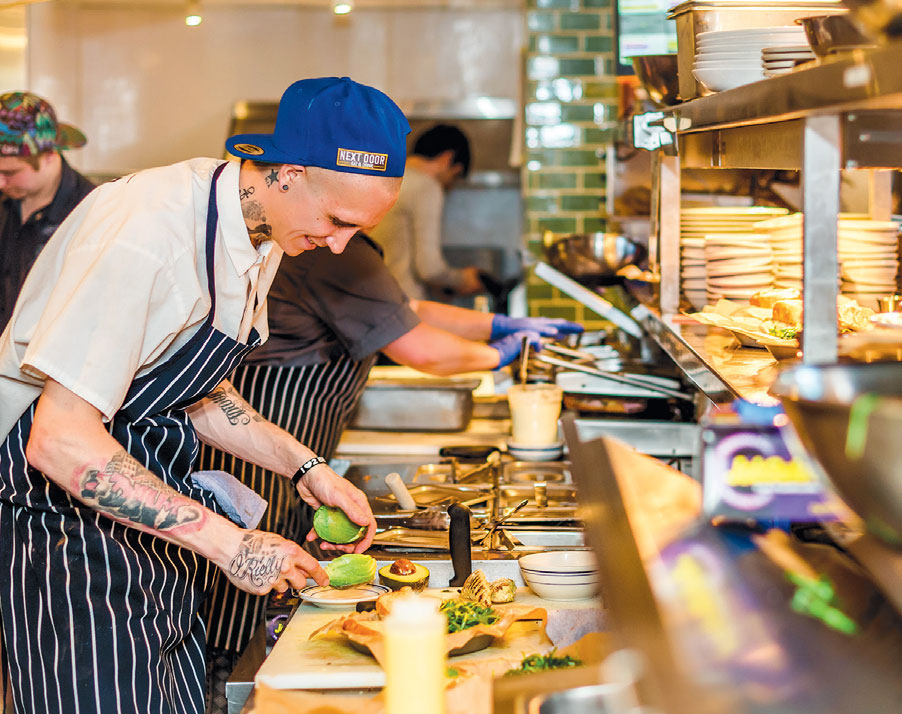 Chef from Next Door
Chef from Next Door
For well-intended chefs and restaurants, vetting the good from the bad is a full-time job. “Real food is what I stand for,” says Kimbal Musk, who founded The Kitchen in Boulder, Colorado, in 2004. “That’s food you can trust to nourish your body, nourish the farmer, and nourish the planet. There are terrific indoor and soil-based farmers and there are indoor and soil-based farmers that aren’t terrific.”
For consumers, however, even well-versed ones with ready access to farmers’ markets, it can be tricky to track where their food is coming from. That becomes exponentially more difficult when, according to the USDA, nearly 50 percent of total U.S. food dollars is spent on meals away from home—to the tune of $799 billion annually.
With chefs feeding us so regularly, they have unprecedented control over what we’re eating and its effects on both our health and the planet. Conscious diners seek out reputable restaurants because they trust the chef to make purchasing decisions that align with their own beliefs.
“People want to know where their food comes from. We want to eat our values,” says Sara Brito, co-founder of the Good Food 100 Restaurants, a nonprofit dedicated to examining chefs’ sourcing practices. At restaurants like Lucques and A.O.C. in Los Angeles, James Beard Award–winning chef and co-owner Suzanne Goin says, “We used to get more questions—like ‘Is this the swordfish we’re not supposed to eat?’—but now our diners trust us and know we’re already in that camp.”
But as revealed in Laura Reiley’s Pulitzer Prize–nominated Tampa Bay Times’ greenwashing story “Farm to Fable” in 2016, not every operation is so transparent. In many cases, a chalkboard menu naming farmers and ranchers records mistakes, if not flat-out lies. For a number of consumers, a restaurant’s word is no longer binding enough to earn their dining dollars.
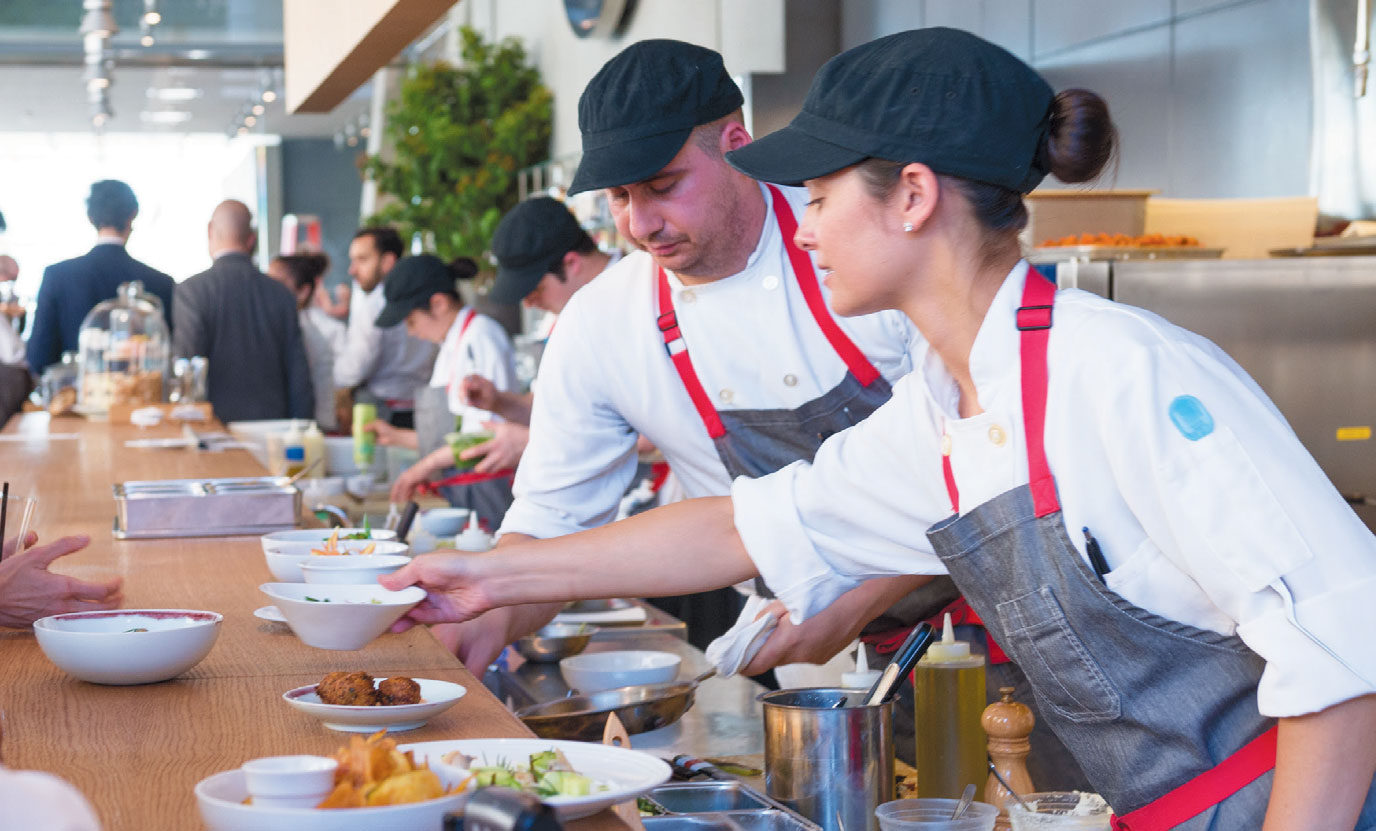 Suzanne Cupps of Untitled, NYC
Suzanne Cupps of Untitled, NYC
So what’s a concerned eater to do?
Enter programs like Brito’s annual Good Food 100 Restaurants list, the James Beard Foundation’s Smart Catch, and the Monterey Bay Aquarium’s Seafood Watch, the latter two of which steer chefs and diners toward more sustainable seafood. These entities serve as third-party auditors designed to keep chefs honest and instill consumer confidence so they are empowered to make the best possible dining decisions. When guests see the organizations’ logos posted on the wall, door, or menu of a restaurant, they know the staff is taking steps to be conscious of the ingredient itself, its producers and purveyors, and the environment.
With the term “farm-to-table” itself getting greenwashed (remember a few years back when McDonald’s claimed to be farm-to-fork?), the newer, more democratic Good Food movement has taken shape. “To me this is much more about all-ingredient sourcing and a bigger awareness of farming practices, waste, sustainability, and health of food systems,” says Renee Erickson, the James Beard Award–winning chef of The Whale Wins, The Walrus & The Carpenter, and other popular restaurants in Seattle.
This is just what organizations like the Good Food 100 measure. And that’s not all. Through its annual survey of restaurants, Brito’s nonprofit takes a snapshot of the restaurant industry at large by examining the impact sustainable supply chains have the state, regional, and national economy. This year’s data reports that the 124 restaurants (from all regions of the country) included on the list spent $78.3 million dollars on good food purchases, which contributed to a $249.4 million economic impact on the national good food economy.
“It would be so much easier to buy produce from just one vendor who isn’t local,” says Suzanne Cupps of NYC’s Untitled at the Whitney, opened by Danny Meyer’s Union Square Hospitality Group in 2015, while addressing the challenges of sourcing from area farmers. “[The producers aren’t] always going to have the tomatoes I like or the same size eggplants. You have to be flexible.”
Sometimes that means taking a dish off the menu or adjusting it last minute. This is easier for high-end restaurants that print their menus daily and have customers who understand the unpredictable world of agriculture.
Depending on where you sit in the country, buying local isn’t always the best—or even an option. Musk cites his salmon fish monger in Alaska, who isn’t close to any of the five locations of The Kitchen, seven outlets of the more affordable Next Door, or the single home of Hedge Row. What matters most, says Musk, is transparency, and being honest about where you’re sourcing your ingredients.
“None of our supply chains are perfect. If we’re serving a salad in January in Colorado we have to figure some things out,” Musk says. “We might have a farmer in California send us arugula. But with total transparency that’s OK because the diner knows what they’re getting.”
Frangos of Farm Burger, which now has 12 locations ranging from Birmingham to Berkeley, agrees, “Farm Burger was built on tradeoffs,” he says. “We have non-negotiables with our beef but we knew we couldn’t only have Georgia potatoes and local greens.”
More than ever, chefs and restaurateurs shoulder the burden of earning—and honoring—the public’s trust that they are doing right. “Chefs and restaurants have the opportunity to sway consumer behavior and shift it in a direction that’s better for everyone,” says Oberholtzer, who now operates more than two dozen Tender Greens’ locations coast-to-coast. “But without buy-in three meals a day from the public, it’s just theoretical.” And that’s critical. The restaurant community can provide the platform and leverage relationships with reputable farmers and producers, but it’s the diner who provides the demand. And only when those two forces intersect does real change takes place. That point came up again and again at 2018’s Slow Food Nations, but it was James Beard Award–winning chef Rick Bayless of Topolobampo, Frontera Grill, and many other acclaimed Chicago restaurants who put it best: “Small steps are the best steps. Focus on the community that’s right in front of you and let that be a beacon to others.”
FOR MORE INFORMATION:
Good Food 100 Restaurants
goodfood10restaurants.org
James Beard Foundation’s Smart Catch
jamesbeard.org/smart-catch
Monterey Bay Aquarium’s Seafood Watch
seafoodwatch.org
WELL INFORMED = WELL FED
A field guide to dining out.
Food is complicated, especially when it comes to eating outside of the home. And with so many choices, going out to dinner (or lunch or breakfast, or even coffee) has morphed from mindless entertainment to the ballot box. Here’s how to exercise your vote while still enjoying your meal.
Commit. “When you ask where [something is] from and you don’t like the answer, don’t order it. Make that decision once and stick to it. That’s your food freedom, and it’s the only way we can get system change,” says butcher Kate Kavanaugh.
Ask questions. “If your server doesn’t know, another person working should—especially the manager and the chef,” says chef Renee Erickson.
Request access. A truly transparent restaurant will walk you through their process. “You want to see our farm? I’ll take you next week. Want to see our processing facility? I’ll set up a tour,” insists farmer and restaurant owner Jason Mann.
Be reasonable. No restaurant is perfect and local isn’t always better. “Any local product is not guaranteed to be good,” restaurateur Kimbal Musk says. “It’s truly a case of knowing your farmer and knowing how they’re growing food.
Keep on, keep on. “If we can convince people to eat food that’s better for their bodies, the environment, and the community, food can have a positive impact on every thread of life,” chef Erik Oberholtzer says.
GOOD IN PHILLY
Our city has plenty of restaurants with local food values, transparency and sustainability at the core of their missions. We cover these chefs and restaurateurs for the good work they do in each issue of this magazine.
Last year, when I was invited to be a contributing editor for the US edition of Truth, Love & Clean Cutlery (Blackwell & Ruth, Nov. 2018), I jumped at the chance. This coffee-table- worthy guidebook showcases the best kind of restaurants around America, places where chefs cook up terrific food while making the world a better a place.
You’ll find these six extraordinary restaurants featured in Truth, Love & Clean Cutlery because of the important role they play when it comes to local food right here in Philly. Make a reservation to show your support of local, sustainably sourced food.
Fork
306 Market St.
215.625.9425
forkrestaurant.com
Hungry Pigeon
743 South 4th St.
215.278.2736
hungrypigeon.com
Russet
1521 Spruce St.
215.546.1521
russetphilly.com
The Rooster
1526 Sansom St.
215.454.6939
roostersoupcompany.com
Sate Kampar
1837 East Passyunk Ave.
267.324.3860
Vedge
1221 Locust St.
215.320.7500
vedgerestaurant.com


